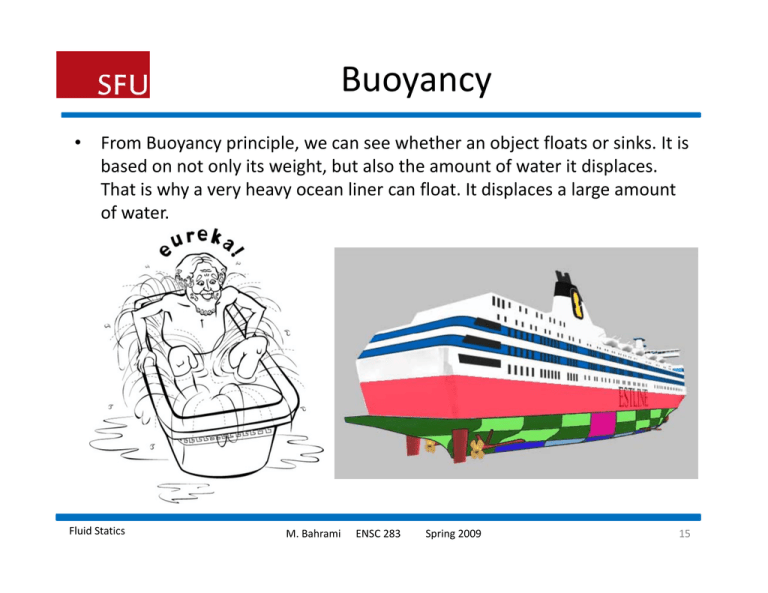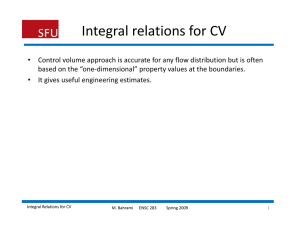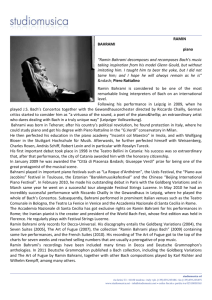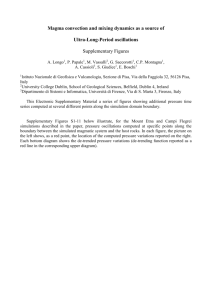Buoyancy
advertisement

Buoyancy • From Buoyancy principle, we can see whether an object floats or sinks. It is based on not only its weight, but also the amount of water it displaces. Th i h That is why a very heavy ocean liner can float. It displaces a large amount h li fl I di l l of water. Fluid Statics M. Bahrami ENSC 283 Spring 2009 15 Archimedes 1st law • A body immersed in a fluid experiences a vertical buoyant force equal to the weight of the fluid it displaces Fluid Statics M. Bahrami ENSC 283 Spring 2009 16 Buoyancy force • The line of action of the buoyant force passes through the center of volume of the displaced body; i.e., the center of mass is computed as if it had uniform density. The point which FB B acts is called the center of buoyancy. Fluid Statics M. Bahrami ENSC 283 Spring 2009 17 Archimedes 2nd law • A floating body displaces its own weight in the fluid in which it floats. In the case of a floating body, only a portion of the body is submerged. Fluid Statics M. Bahrami ENSC 283 Spring 2009 18 Example • A spherical body has a diameter of 1.5 m, weighs 8.5 kN, and is anchored to the sea floor with a cable as is shown in the figure. C l l t the Calculate th tension t i off the th cable bl when h th body the b d is i completely l t l immersed, assume γsea‐water =10.1 kN/m3. Seawater FB d W T Cable Fluid Statics M. Bahrami ENSC 283 Spring 2009 19 Pressure in rigid‐body motion • Fluids move in rigid‐body motion only when restrained by confining walls. In rigid‐body motion, all particles are in combined translation and rotation, and there h i no relative is l i motion i between b particles. i l Fluid Statics M. Bahrami ENSC 283 Spring 2009 20 Rigid‐body motion cont’d The pressure gradient acts in the direction of g – a and lines of constant pressure are perpendicular to this direction and thus tilted at angle θ • • The rate of increase of pressure in the direction g The rate of increase of pressure in the direction g – a is greater than in a is greater than in ordinary hydrostatics Fluid Statics M. Bahrami ENSC 283 Spring 2009 21 Rigid‐body rotation • Consider a fluid rotating about the z‐axis without any translation at a constant angular velocity Ω for a long time. The acceleration id given by: The forced balance becomes: Fluid Statics M. Bahrami ENSC 283 Spring 2009 22 Rigid‐body motion cont’d The pressure field can be found by equating like components • After integration with respect to r and z with p=p0 at (r,z) = (0,0): • The pressure is linear in z and parabolic in r. The constant pressure surfaces can be calculated using Fluid Statics M. Bahrami ENSC 283 Spring 2009 23 Pressure measurement • • Pressure is the force per unit area and can be imagined as the effects related to fluid molecular bombardment of a surface. There are many devices for both a static fluid and moving fluid pressure measurements. Manometer, barometer, Bourdon gage, McLeod gage, Knudsen gage are only a few examples. Fluid Statics M. Bahrami ENSC 283 Spring 2009 24




